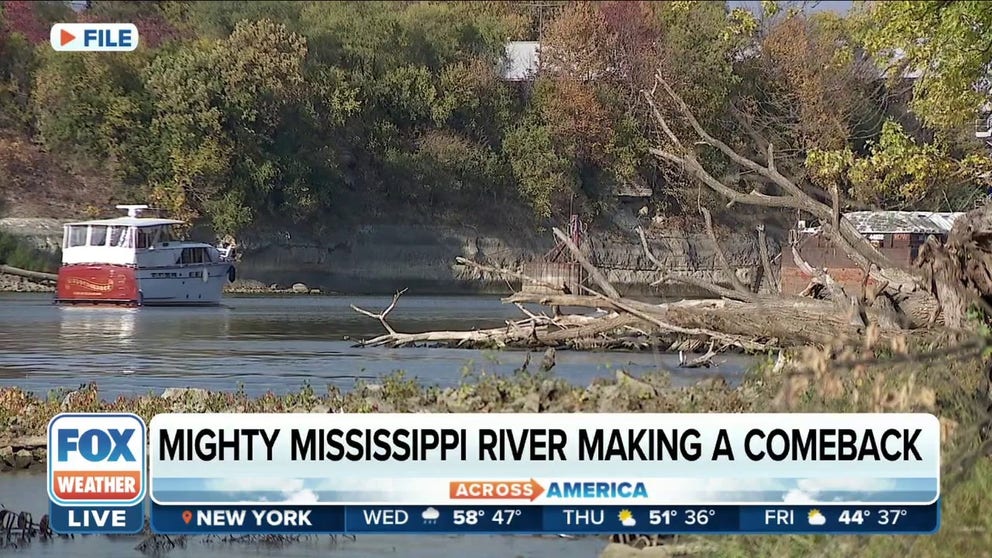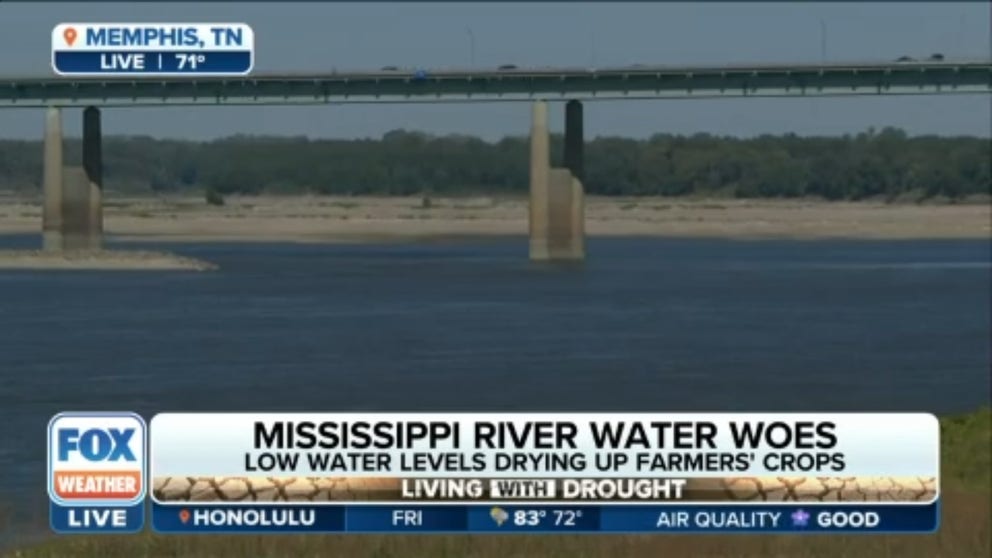Mississippi River getting a refill from storms, moves cargo once again
Ol' Man River hit record lows in the current drought which halted ship traffic, creating a log-jam of goods from soybeans to gasoline and all all but halting tourist riverboats. Rainy relief is on the way.
The Mighty Mississippi River is making a comeback
Recent rains during this very soggy week for the South are giving new live to the Mississippi's barge trade. The early Christmas gift from Mother Nature freed countless grounded ships and allows shippers to load the barges closer to capacity.
Barge and ship captains across the Mississippi River are getting an early Christmas gift from Mother Nature – rain and lots of it.
Thirsty Ol' Man River is finally drinking up winter rains, giving hope to the thousands of grounded captains, fearful farmers and stores waiting for the 500 tons of merchandise and commodities the river transports every year, according to the U.S. Bureau of Transportation Statistics.
SOUTHERN SOAKER POSES MULTIDAY FLASH FLOOD THREAT FROM OKLAHOMA TO TENNESSEE TO KENTUCKY
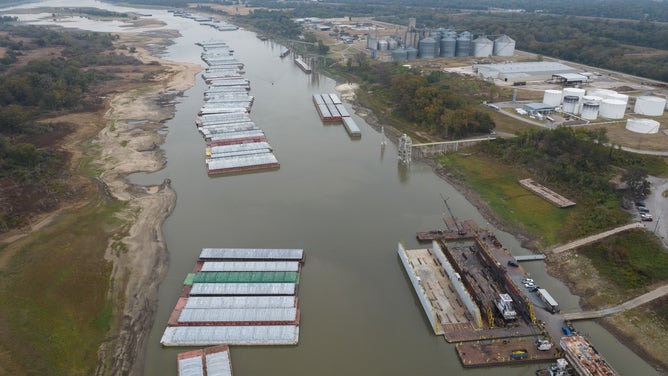
A backup of barges due to low water levels on the Mississippi along the Port of Greenville in Greenville, Mississippi.
(Rory Doyle/Bloomberg / Getty Images)
Moderate and severe drought along the 2,300 mile-long river sapped important ports like Cairo, Illinois which showed river bottom not seen for over 100 years. This week, most of us relying on the supply chain are breathing a sigh of relief.
WHY HISTORICALLY LOW LEVELS OF THE MISSISSIPPI RIVER MAY AFFECT WHAT YOU PAY AT THE GROCERY STORE
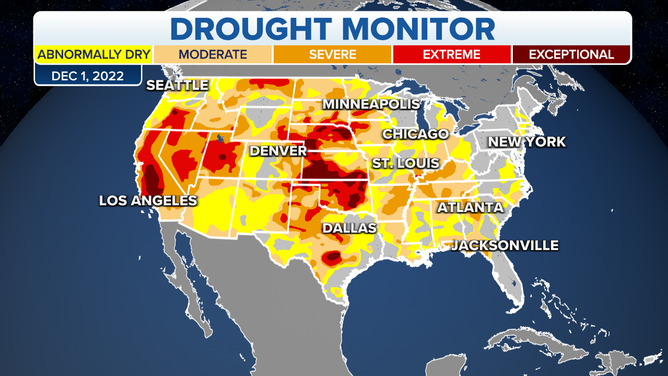
NOAA's Drought Monitor shows much of the Mississippi and Ohio Rivers under moderate and severe drought.
(NOAA / FOX Weather)
Where the drought is letting up
"We're seeing the best rise is from Cairo, Illinois all the way down to the Gulf of Mexico. It's about 973 miles of the river from Cairo down to the Gulf," Pat Chambers, Chief of Operations in the Mississippi Valley for the U.S. Army Corp of Engineers told FOX Weather.
"The recent rains over the last couple of days that we've gotten have raised the gauge reading in Cairo about a foot, which is good relief for us," he continued. "It helps us with our dredging operations and also helps continue moving traffic along the river."
Meteorologists and hydrologists on his team see more good news on the horizon.
"Over the next four or five days, we'll lose about another three feet accrued, but then right behind that, we're going to see a 9-foot rise in the river at Cairo based on the rainfall that we're seeing out over the next six days," said Chambers. "So, that's going to be good."
SALTWATER CREEPING UP MISSISSIPPI RIVER AMID LOWEST LEVELS IN A DECADE
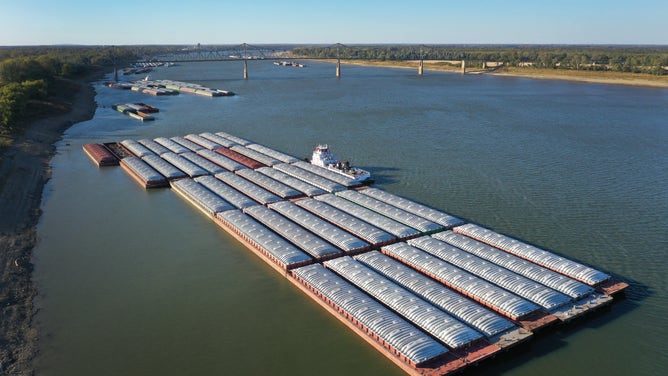
Cairo lies on the junction of the Ohio and Mississippi Rivers. Several barges are forced to stop and wait on the banks while crews dredge.
(Scott Olson / Getty Images)
How low water levels impede the movement of cargo
Water levels from Cairo to St. Louis remain at critical levels. Every day the boats can't travel is another chink in the supply chain which goes down the line. Sometimes captains are forced to take a reduced load, shortchanging the recipient and leaving the supplier to wonder what to do with time-sensitive products, such as grains.
"We did have some barges stuck. Some of our ports and harbors had some barges to where they couldn't get out, couldn't load deep enough. They like to load to where the bottom of the barge is sitting 9-foot to 11-foot below the water's surface," explained Chambers.
"They've had to reduce that draft on all their largest (barges) amount to about 9-foot, 9-foot-6," he added. "And so, they're losing about a foot and a half draft or a load of what they're being able to put into those barges and move."
LOW MISSISSIPPI WATER LEVELS REVEAL CENTURY-OLD SHIPWRECK
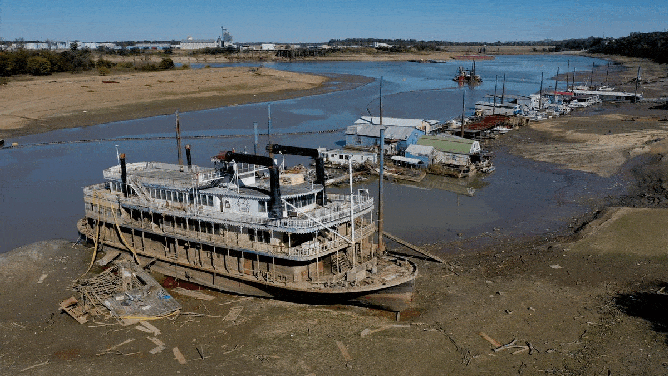
Images showing low water levels along the Mississippi River.
(Getty Images)
How the drought impacts the economy
Consumers will pay the ultimate price, according to Senior Vice President of Waterways Council Deb Calhoun.
"And now, you could see higher prices for electricity," she said. "You could see impacts of the grocery store in terms of higher meat costs or for building and construction materials to be determined."
Take a look at the 500 tons (or 1 million pounds) of products like fresh meat and vegetables with a shelf life, along with vehicle parts and lumber that will hold up an entire project.
"Moving all those agricultural products from Midwest farms and throughout the country (and) to the Gulf for export – those global buyers are turning to the United States for those products, and they depend upon the most cost-effective way to move those bulk commodities, and that is by the inland waterways system," said Calhoun of rivers, which are critical arteries of commerce.
HOW TO WATCH FOX WEATHER ON TV
"So, it's critically important for agriculture products, of course, also energy products to keep the lights and power on. It's important for our construction and building trades in terms of cement, moving steel, aggregate materials," continued Calhoun. "We're also moving large cargoes on our inland systems, such as wind turbine blades. Also, NASA uses it to move some of its shuttle parts for the space program."
Relief in sight?
Mississippi River water woes: Low water levels impacting millions of Americans
Slow shipping along the Mississippi River in impacting farmers' profits. FOX Weather's Nicole Valdes reports.
Even on the main stream and channel of the Mississippi, barges wait for hours – even days – for emergency dredging, or digging out the bottom of the river.
"We'll see barges stack up what we call a ‘queue’. They have to stop and push them to the bank and wait for us to finish dredging operations to get that depth back to where they need it to be in order to move forward or move either up-bounds or down-bounds," said Chambers. "But those are short stoppages, generally for 24 hours to maybe two days at the most."
Calhoun said that the river would need a month's worth of rain in just a few days to make up the deficit. This week will be a drop in the bucket, but an important one.
